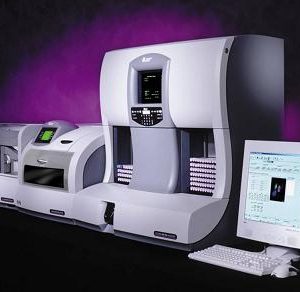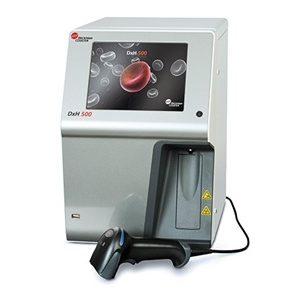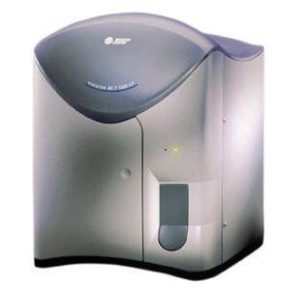Description
Quality That Counts
Trust your results—the first time—with high-quality hematology analyzers that deliver precise, accurate results and advanced cellular insights.
Achieve superior RBC, PLT and WBC differentials through near native-state cellular characterization
Deliver high-confidence results on the first run—minimizing reruns and reflex tests
Improve slide interpretation with intelligent technology that helps optimize smearing, ensuring consistent slide quality
Productivity That Liberates
Free up your busy laboratory’s hematology team and empower your staff to focus on samples and tasks that truly need attention
Simplify workload planning with predictable hematology workflows that let you save time for the unexpected
Optimize your limited resources with reliable flagging
Savings That Empower
Tap into powerful savings to help your lab devote time, budget, and resources where they are needed most
Streamline QA/QC processes through customizable, automated technology with daily reminders and remote support
Save time, reduce costs, and optimize hematology instrument usage with fewer reflex tests
Reduce hematology reagent use and associated costs
Reallocate up to 200 minutes of daily run-time previously spent on reflex testing1
Reduce overhead costs like electricity and maintenance
Technical Specifications
Methodology
Enhanced Coulter Principle, VCS 360 with DataFusion
Parameters
CBC: WBC, RBC, HGB, HCT, MCV, MCH, MCHC, RDW, RDW-SD, PLT, MPV
Differential: NE, LY, MO, EO, BA, NRBC, NE#, LY#, MO#, EO#, BA#, NRBC #, MDW (when enabled)
Retic: RET, RET#, MRV, IRF
Body Fluids (Cerebrospinal, Serous, or Synovial): RBC, TNC
Throughput (tests per hour)
Up to 100 samples/hour
Sample Volumes
165 μL aspiration volume; 0.5 ml dead volume. Predilute: 50 μL whole blood into 200 μL of diluent
Analytical Measuring Ranges2
Whole Blood (CBC)
Parameters
Units
Analytical Measuring Range
WBC
x103 cells/μL
0.050–400.000
RBC
x106 cells/μL
0.005–8.500
HGB
g/dL
0.10–25.50
MCV
fL
50.00–150.00
RDW
%
10.00–40.0
RDW-SD
fL
15.00–150.00
PLT
x103 cells/μL
3.0–3000.0
MPV
fL
5.00–25.00
Body Fluids
TNC
cells/mm3
20–89,000
RBC
cells/mm3
1,000–6,200,000
Data Management
Up to 50,000 patient results with histograms, scatter plots, and demographics
100,000 patient results with graphics for power computer
Quality Assurance
QC with Levy-Jennings graph; XB/XM for moving averages, daily check, intelligent quality monitoring, MRV, IRF, customizable calibration and QC reminders and alerts, auto export of QC
Acoustic Noise Level
≤ 60 dBa
Radio Frequency and Interference Immunity
Meet the product level standards EN 61326-1 (Electrical Equipment for Measurement, Control, and Laboratory Use—EMC Requirements), and EN 61326-2-6 (Part 2, Specific Requirements for In-Vitro Diagnostic Devices)
Power Consumption
DxH 900 SPM: 520 W (1775 BTU/hour), Monitor: 35 W (120 BTU/hour), DxH Power Computer: 160 W (546 BTU/hour)
Dimensions and weight3
Width
Height
Depth
Weight
76.2 cm (30 in.)
176.53 cm (69.5 in.), with cover closed
199.39 cm (78.5 in.), with cover open
83.82 cm (33 in.), including the removable back panel
80 cm (31.5 in.), excluding the removable back panel
~292.11 kg (644 lbs.),
including monitor & computer
~287.12 kg (633 lbs.),
excluding computer
Additional Clearance
15.2 cm (6.0 in.) per side of instrument for troubleshooting; 3.8 cm (1.5 in.) behind instrument for sufficient cooling
Maintenance and Troubleshooting
Service
New Preventative Maintenance (PM) schedule with customer care visits
Support
Onboard IFU and Instructional Videos, Automated QC and calibration reminders, PROService
Analyzer Downtime
Minimum of 30 minutes in cleaner every 24 hours with automatic daily checks
Research Use Only Parameters
Available RUO Parameters4
BFM, BFM#, BFP, EGC, EGC#, HLR, HLR#, LHD, MAF, MSCV, PCT, PDW, RDWR, RDWR-SD, RSF, UGC, UGC#, UWROP, WDOP, WNOP, WROP, CPD (refer to reference 4 for additional RUO parameters)








Reviews
There are no reviews yet.